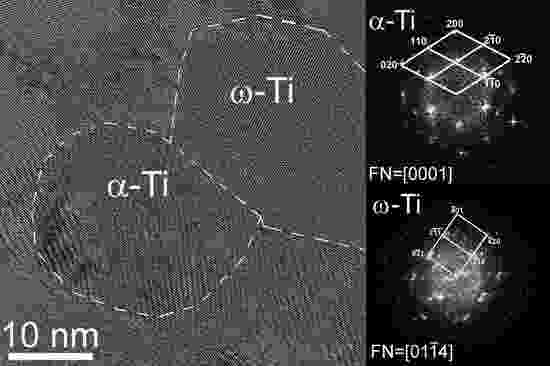The α → ω Transformation in Titanium-Cobalt Alloys under High-Pressure Torsion
Abstract
:1. Introduction
2. Experimental
3. Results
4. Discussion
5. Conclusions
Acknowledgments
Author Contributions
Conflicts of Interest
References
- Donachie, M.J., Jr. Titanium: A Technical Guide, 2nd ed.; ASM International: Geauga County, OH, USA, 2000. [Google Scholar]
- Errandonea, D.; Meng, Y.; Somayazulu, M.; Häusermann, D. Pressure-induced α → ω transition in Titanium metal: A systematic study of the effects of uniaxial stress. Phys. B 2005, 355, 116–125. [Google Scholar] [CrossRef]
- Trinkle, D.R.; Hennig, R.G.; Srinivasan, S.G.; Hatch, D.M.; Jones, M.D.; Stokes, H.T.; Albers, R.C.; Wilkins, J.W. New mechanism for the α to ω martensitic transformation in pure titanium. Phys. Rev. Lett. 2003, 91, 025701. [Google Scholar] [CrossRef] [PubMed]
- Sikka, S.K.; Vohra, Y.K.; Chidambaram, R. ω-phase in materials. Prog. Mater. Sci. 1982, 27, 245–310. [Google Scholar] [CrossRef]
- Hickman, B.S. The formation of ω phase in Ti and Zr alloys: A review. J. Mater. Sci. 1969, 4, 554–563. [Google Scholar] [CrossRef]
- Gupta, S.C.; Joshi, K.D.; Banerjee, S. Experimental and theoretical investigations on d and f electron systems under high pressure. Metall. Mater. Trans. A 2008, 39, 1593–1601. [Google Scholar] [CrossRef]
- Hennig, R.; Trinkle, D.R.; Bouchet, J.; Srinivasan, S.G.; Albers, R.C.; Wilkins, J.W. Impurities block the α to ω martensitic transformation in Titanium. Nat. Mater. 2005, 4, 129–133. [Google Scholar] [CrossRef] [PubMed]
- Afonikova, N.S.; Degtyareva, V.F.; Litvin, Y.A.; Rabinkin, A.G.; Skakov, Y.A. Superconductivity and crystal structure of Ti-Nb alloys after high-pressure action up 120 kbar. Sov. Phys. Sol. State 1973, 15, 746–749. [Google Scholar]
- Vohra, Y.K.; Sikka, S.K.; Menon, E.S.K.; Krishnan, R. High-pressure studies on a prototype ω forming alloy system. Acta Metall. 1981, 29, 457–470. [Google Scholar] [CrossRef]
- Dey, G.K.; Tewari, R.; Banerjee, S.; Jyoti, G.; Gupta, S.C.; Joshi, K.D.; Sikka, S.K. Formation of a shock deformation induced ω phase in Zr20Nb alloy. Acta Mater. 2004, 52, 5243–5254. [Google Scholar] [CrossRef]
- Valiev, R.Z.; Islamgaliev, R.K.; Alexandrov, I. Bulk nanostructured materials from severe plastic deformation. Prog. Mater. Sci. 2000, 45, 103–189. [Google Scholar] [CrossRef]
- Straumal, B.; Korneva, A.; Zięba, P. Phase transitions in metallic alloys driven by the high pressure torsion. Arch. Civ. Mech. Eng. 2014, 14, 242–249. [Google Scholar] [CrossRef]
- Lojkowski, W.; Djahanbakhsh, M.; Burkle, G.; Gierlotka, S.; Zielinski, W.; Fecht, H.J. Nanostructure formation on the surface of railway tracks. Mater. Sci. Eng. A 2001, 303, 197–208. [Google Scholar] [CrossRef]
- Gavriljuk, V.G. Decomposition of cementite in pearlitic steel due to plastic deformation. Mater. Sci. Eng. A 2003, 345, 81–89. [Google Scholar] [CrossRef]
- Sauvage, X.; Wetscher, F.; Pareige, P. Mechanical alloying of Cu and Fe induced by severe plastic deformation of a Cu–Fe composite. Acta Mater. 2005, 53, 2127–2135. [Google Scholar] [CrossRef]
- Straumal, B.B.; Baretzky, B.; Mazilkin, A.A.; Phillipp, F.; Kogtenkova, O.A.; Volkov, M.N.; Valiev, R.Z. Formation of nanograined structure and decomposition of supersaturated solid solution during high pressure torsion of Al–Zn and Al–Mg. Acta Mater. 2004, 52, 4469–4478. [Google Scholar] [CrossRef]
- Mazilkin, A.A.; Straumal, B.B.; Rabkin, E.; Baretzky, B.; Enders, S.; Protasova, S.G.; Kogtenkova, O.A.; Valiev, R.Z. Softening of nanostructured Al–Zn and Al–Mg alloys after severe plastic deformation. Acta Mater. 2006, 54, 3933–3939. [Google Scholar] [CrossRef]
- Straumal, B.B.; Protasova, S.G.; Mazilkin, A.A.; Rabkin, E.; Goll, D.; Schütz, G.; Baretzky, B.; Valiev, R. Deformation-driven formation of equilibrium phases in the Cu–Ni alloys. J. Mater. Sci. 2012, 47, 360–367. [Google Scholar] [CrossRef]
- Straumal, B.B.; Kilmametov, A.R.; Kucheev, Y.O.; Kurmanaeva, L.; Ivanisenko, Y.; Baretzky, B.; Korneva, A.; Zięba, P.; Molodov, D.A. Phase transitions during high pressure torsion of Cu–Co alloys. Mater. Lett. 2014, 118, 111–114. [Google Scholar] [CrossRef]
- Straumal, B.; Valiev, R.; Kogtenkova, O.; Zieba, P.; Czeppe, T.; Bielanska, E.; Faryna, M. Thermal evolution and grain boundary phase transformations in severe deformed nanograined Al–Zn alloys. Acta Mater. 2008, 56, 6123–6131. [Google Scholar] [CrossRef]
- Cepeda-Jiménez, C.M.; García-Infanta, J.M.; Zhilyaev, A.P.; Ruano, O.A.; Carreño, F. Influence of the thermal treatment on the deformation-induced precipitation of a hypoeutectic Al–7 wt % Si casting alloy deformed by high-pressure torsion. J. Alloys Compd. 2011, 509, 636–643. [Google Scholar] [CrossRef] [Green Version]
- Ivanisenko, Y.; Lojkowski, W.; Valiev, R.Z.; Fecht, H.J. The mechanism of formation of nanostructure and dissolution of cementite in a pearlitic steel during high pressure torsion. Acta Mater. 2003, 51, 5555–5570. [Google Scholar] [CrossRef]
- Straumal, B.B.; Mazilkin, A.A.; Protasova, S.G.; Dobatkin, S.V.; Rodin, A.O.; Baretzky, B.; Goll, D.; Schütz, G. Fe–C nanograined alloys obtained by high pressure torsion: Structure and magnetic properties. Mater. Sci. Eng. A 2009, 503, 185–189. [Google Scholar] [CrossRef]
- Sagaradze, V.V.; Shabashov, V.A. Deformation-induced anomalous phase transformations in nanocrystalline FCC Fe–Ni based alloys. Nanostruct. Mater. 1997, 9, 681–684. [Google Scholar] [CrossRef]
- Ohsaki, S.; Kato, S.; Tsuji, N.; Ohkubo, T.; Hono, K. Bulk mechanical alloying of Cu–Ag and Cu/Zr two-phase microstructures by accumulative roll-bonding process. Acta Mater. 2007, 55, 2885–2895. [Google Scholar] [CrossRef]
- Straumal, B.B.; Dobatkin, S.V.; Rodin, A.O.; Protasova, S.G.; Mazilkin, A.A.; Goll, D.; Baretzky, B. Structure and properties of nanograined Fe–C alloys after severe plastic deformation. Adv. Eng. Mater. 2011, 13, 463–469. [Google Scholar] [CrossRef]
- Sergueeva, A.V.; Song, C.; Valiev, R.Z.; Mukherjee, A.K. Structure and properties of amorphous and nanocrystalline NiTi prepared by severe plastic deformation and annealing. Mater. Sci. Eng. A 2003, 339, 159–165. [Google Scholar] [CrossRef]
- Prokoshkin, S.D.; Khmelevskaya, I.Y.; Dobatkin, S.V.; Trubitsyna, I.B.; Tatyanin, E.V.; Stolyarov, V.V.; Prokofiev, E.A. Alloy composition, deformation temperature, pressure and post-deformation annealing effects in severely deformed Ti-Ni based shape memory alloys. Acta Mater. 2005, 53, 2703–2714. [Google Scholar] [CrossRef]
- Sauvage, X.; Renaud, L.; Deconihout, B.; Blavette, D.; Ping, D.H.; Hono, K. Solid state amorphization in cold drawn Cu/Nb wires. Acta Mater. 2001, 49, 389–394. [Google Scholar] [CrossRef]
- Miyazaki, T.; Terada, D.; Miyajima, Y.; Suryanarayana, C.; Murao, R.; Yokoyama, Y.; Sugiyama, K.; Umemoto, M.; Todaka, T.; Tsuji, N. Synthesis of non-equilibrium phases in immiscible metals mechanically mixed by high pressure torsion. J. Mater. Sci. 2011, 46, 4296–4301. [Google Scholar] [CrossRef]
- Mazilkin, A.A.; Abrosimova, G.E.; Protasova, S.G.; Straumal, B.B.; Schütz, G.; Dobatkin, S.V.; Bakai, A.S. Transmission electron microscopy investigation of boundaries between amorphous “grains” in Ni50Nb20Y30 alloy. J. Mater. Sci. 2011, 46, 4336–4342. [Google Scholar] [CrossRef]
- Straumal, B.B.; Mazilkin, A.A.; Protasova, S.G.; Goll, D.; Baretzky, B.; Bakai, A.S.; Dobatkin, S.V. Formation of two amorphous phases in the Ni60Nb18Y22 alloy after high pressure torsion. Kovove Mater. Metall. Mater. 2011, 49, 17–22. [Google Scholar] [CrossRef]
- Glezer, A.M.; Plotnikova, M.R.; Shalimova, A.V.; Dobatkin, S.V. Severe plastic deformation of amorphous alloys: I. Structure and mechanical properties. Bull. Russ. Acad. Sci. Phys. 2009, 73, 1233–1236. [Google Scholar] [CrossRef]
- Abrosimova, G.E.; Aronin, A.S.; Dobatkin, S.V.; Kaloshkin, S.D.; Matveev, D.V.; Rybchenko, O.G.; Tatyanin, E.V.; Zverkova, I.I. The formation of nanocrystalline structure in amorphous Fe-Si-B alloy by severe plastic deformation. J. Metastab. Nanocryst. Mater. 2005, 24, 69–72. [Google Scholar] [CrossRef]
- Henits, P.; Révész, A.; Zhilyaev, A.P.; Kovács, Z. Severe plastic deformation induced nanocrystallization of melt-spun Al85Y8Ni5Co2 amorphous alloy. J. Alloys Compd. 2008, 461, 195–199. [Google Scholar] [CrossRef]
- Zilbershtein, V.A.; Nosova, G.I.; Estrin, E.I. α-ω transformation in Ti and Zr. Fiz. Met. Metalloved. 1973, 35, 584–589. [Google Scholar]
- Zilbershtein, V.A.; Chistotina, N.P.; Zharov, A.A.; Grishina, N.S.; Estrin, E.I. α-ω transformation in Ti and Zr by shear deformation under pressure. Fiz. Met. Metalloved. 1975, 39, 445–447. [Google Scholar]
- Bridgman, P.W. Rough compressions of 177 substances to 40,000 atm. Proc. Am. Acad. Arts Sci. 1948, 76, 71–87. [Google Scholar] [CrossRef]
- Kutzar, A.R.; Pawlovskii, M.N.; Komissarov, V.V. Observation of a two-wave shock configuration in Titanium. JETP Lett. 1982, 35, 108–112. [Google Scholar]
- Jamieson, J.C. Crystal structures of Titanium, zirconium, and hafnium at high pressures. Science 1963, 140, 72–73. [Google Scholar] [CrossRef] [PubMed]
- Jamieson, J.C.; Lawson, A.W. X-ray diffraction studies in the 100 kilobar pressure range. J. Appl. Phys. 1962, 33, 776–780. [Google Scholar] [CrossRef]
- Jamieson, J.C. Crystal structures at high pressures of metal-lic modification of silicon and germanium. Science 1963, 139, 762–763. [Google Scholar] [CrossRef] [PubMed]
- Jayaraman, A.; Clement, W.; Kennedy, G.C. Solid-solid transitions in Titanium and zirconium at high pressures. Phys. Rev. 1963, 131, 644–649. [Google Scholar] [CrossRef]
- Zhang, J.; Zhao, Y.; Hixon, R.S.; Gray, G.T., III; Wang, L.; Wataru, U.; Saito, H.; Hattori, T. Experimental constraints on the phase diagram of Titanium metal. J. Phys. Chem. Solid 2008, 69, 2559–2563. [Google Scholar] [CrossRef]
- Vohra, Y.K.; Sikka, S.K.; Vaidya, S.N.; Chidambaram, R. Impurity effects and reaction kinetics of the pressure-induced α→ω transformation in Ti. J. Phys. Chem. Solid 1977, 38, 1293–1296. [Google Scholar] [CrossRef]
- Akahama, Y.; Kawamura, H.; Bihan, T.L. New δ (Distorted-bcc) Titanium to 220 GPa. Phys. Rev. Lett. 2001, 87, 275503. [Google Scholar] [CrossRef] [PubMed]
- Vohra, Y.K.; Spencer, P.T. Novel γ-phase of Titanium metal at megabar pressures. Phys. Rev. Lett. 2001, 86, 3068–3071. [Google Scholar] [CrossRef] [PubMed]
- Ming, L.C.; Manghnani, M.; Katahara, M. Phase transformations in the Ti-V system under high pressure up to 25 GPa. Acta Metall. 1981, 29, 479–485. [Google Scholar] [CrossRef]
- Ivanisenko, Y.; Kilmametov, A.; Roesner, H.; Valiev, R.Z. Evidence of α→ω phase transition in Titanium after high pressure torsion. Int. J. Mater. Res. 2008, 99, 36–41. [Google Scholar] [CrossRef]
- Kilmametov, A.R.; Ivanisenko, Y.; Mazilkin, A.A.; Straumal, B.B.; Gornakova, A.S.; Fabrichnaya, O.B.; Kriegel, M.J.; Rafaja, D.; Hahn, H. The α→ω and β→ω phase transformations in Ti–Fe alloys under high-pressure torsion. Acta Mater. 2018, 144, 337–351. [Google Scholar] [CrossRef]
- Straumal, B.B.; Kilmametov, A.R.; Ivanisenko, Y.; Gornakova, A.S.; Mazilkin, A.A.; Kriegel, M.J.; Fabrichnaya, O.B.; Baretzky, B.; Hahn, H. Phase transformations in Ti-Fe alloys induced by high pressure torsion. Adv. Eng. Mater. 2015, 17, 1835–1841. [Google Scholar] [CrossRef]
- Straumal, B.B.; Pontikis, V.; Kilmametov, A.R.; Mazilkin, A.A.; Dobatkin, S.V.; Baretzky, B. Competition between precipitation and dissolution in Cu–Ag alloys under high pressure torsion. Acta Mater. 2017, 122, 60–71. [Google Scholar] [CrossRef]
- Wojdyr, M. Fityk: A general-purpose peak fitting program. J. Appl. Crystallogr. 2010, 43, 1126–1128. [Google Scholar] [CrossRef]
- Lábár, J.L. Consistent indexing of a (set of) SAED pattern(s) with the Process Diffraction program. Ultramicroscopy 2005, 103, 237–249. [Google Scholar] [CrossRef] [PubMed]
- Greeff, C.W.; Trinkle, D.R.; Albers, R.C. Shock-induced α–ω transition in Titanium. J. Appl. Phys. 2001, 90, 2221–2226. [Google Scholar] [CrossRef]
- Tegner, B.E.; Ackland, G.J. Pseudopotential errors in Titanium. Comput. Mater. Sci. 2012, 52, 2–6. [Google Scholar] [CrossRef]
- Mendelev, M.I.; Underwood, T.L.; Ackland, G.J. Development of an interatomic potential for the simulation of defects, plasticity, and phase transformations in Titanium. J. Chem. Phys. 2016, 145, 154102. [Google Scholar] [CrossRef] [PubMed]
- Rawat, S.; Mitra, N. Compression twinning and structural phase transformation of single crystal Titanium under uniaxial compressive strain conditions: Comparison of inter-atomic potentials. Comput. Mater. Sci. 2017, 126, 228–237. [Google Scholar] [CrossRef]
- Dai, J.H.; Song, Y.; Yang, R. Influence of impurities on phase stability of martensites in Titanium. Philos. Mag. 2012, 92, 2272–2285. [Google Scholar] [CrossRef]
- Trinkle, D.R.; Jones, M.D.; Hennig, R.G.; Rudin, S.P.; Albers, R.C.; Wilkins, J.W. Empirical tight-binding model for Titanium phase transformations. Phys. Rev. B 2006, 73, 094123. [Google Scholar] [CrossRef]
- Hennig, R.G.; Lenosky, T.J.; Trinkle, D.R.; Rudin, S.P.; Wilkins, J.W. Classical potential describes martensitic phase transformations between the α, ß, and ω Titanium phases. Phys. Rev. B 2008, 78, 054121. [Google Scholar] [CrossRef]
- Rudin, S.P.; Jones, M.D.; Albers, R.C. Thermal stabilization of the hcp phase in titanium. Phys. Rev. B 2004, 69, 094117. [Google Scholar] [CrossRef]
- Huang, L.-F.; Grabowski, B.; McEniry, E.; Trinkle, D.R.; Neugebauer, J. Importance of coordination number and bond length in Titanium revealed by electronic structure investigations. Phys. Status Solid B 2015, 252, 1907–1924. [Google Scholar] [CrossRef]
- Zarkevich, N.A.; Johnson, D.D. Titanium α → ω phase transformation pathway and a predicted metastable structure. Phys. Rev. B 2016, 93, 020104. [Google Scholar] [CrossRef]
- Jafari, M.; Jahandoost, A.; Vaezzadeh, M.; Zarifi, N. Effect of pressure on the electronic structure of hcp Titanium. Condens. Matter Phys. 2011, 14, 23601. [Google Scholar] [CrossRef]
- Kraposhin, V.S.; Talis, A.L.; Wang, Y.J. Description of polymorphic transformations of Ti and Zr in the framework of the algebraic geometry. Mater. Sci. Eng. A 2006, 438–440, 85–89. [Google Scholar] [CrossRef]
- Ikeda, Y.; Tanaka, I. Stability of the ω structure of transition elements. Phys. Rev. B 2016, 93, 094108. [Google Scholar] [CrossRef]
- Kim, S.-H.; Kang, S.J.; Park, M.-H.; Yang, C.-W.; Lee, H.-C.; Han, H.N.; Kim, M. Vacancy-mediated ω-assisted α-phase formation mechanism in titanium–molybdenum alloy. Acta Mater. 2015, 83, 499–506. [Google Scholar] [CrossRef]
- Duffy, T.S.; Shen, G.; Heinz, D.L.; Shu, J.; Ma, Y.; Mao, H.K.; Hemley, R.J.; Singh, A.K. Lattice strains in gold and rhenium under nonhydrostatic compression to 37 GPa. Phys. Rev. B 1999, 60, 15063. [Google Scholar] [CrossRef]
- Loubeyre, P.; le Toulec, R.; Häusermann, D.; Hanfland, M.; Hemley, R.; Mao, H.K.; Finger, L.W. X-ray diffraction and equation of state of hydrogen at megabar pressures. Nature 1996, 383, 702–704. [Google Scholar] [CrossRef]
- Kilmametov, A.; Ivanisenko, Y.; Straumal, B.B.; Mazilkin, A.A.; Gornakova, A.S.; Kriegel, M.J.; Fabrichnaya, O.B.; Rafaja, D.; Hahn, H. Transformations of α′ martensite in Ti–Fe alloys under high pressure torsion. Scr. Mater. 2017, 136, 46–49. [Google Scholar] [CrossRef]
- Edalati, K.; Matsubara, E.; Horita, Z. Processing pure Ti by high-pressure torsion in wide ranges of pressures and strain. Metall. Mater. Trans. A 2009, 40, 2079–2086. [Google Scholar] [CrossRef]
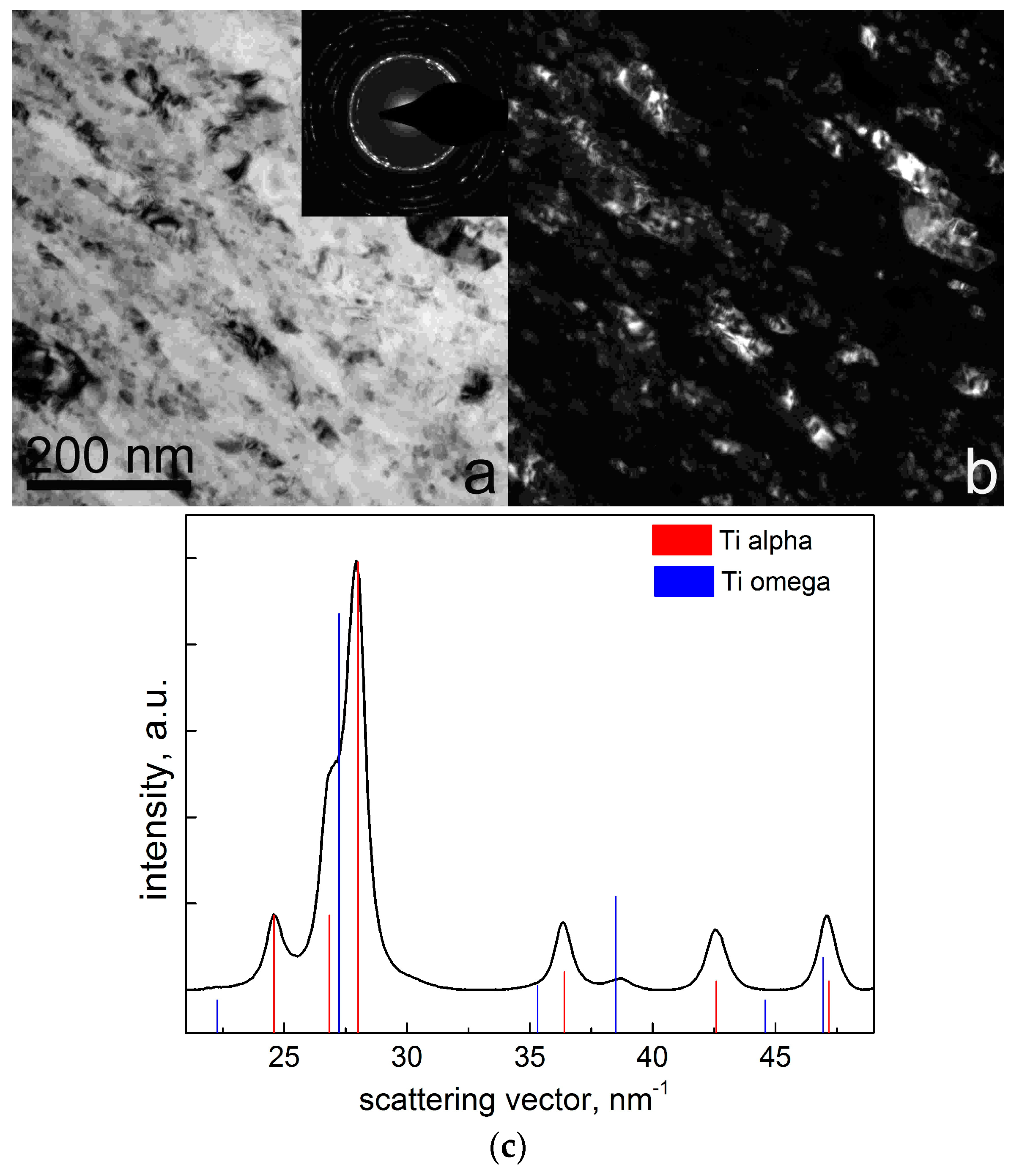
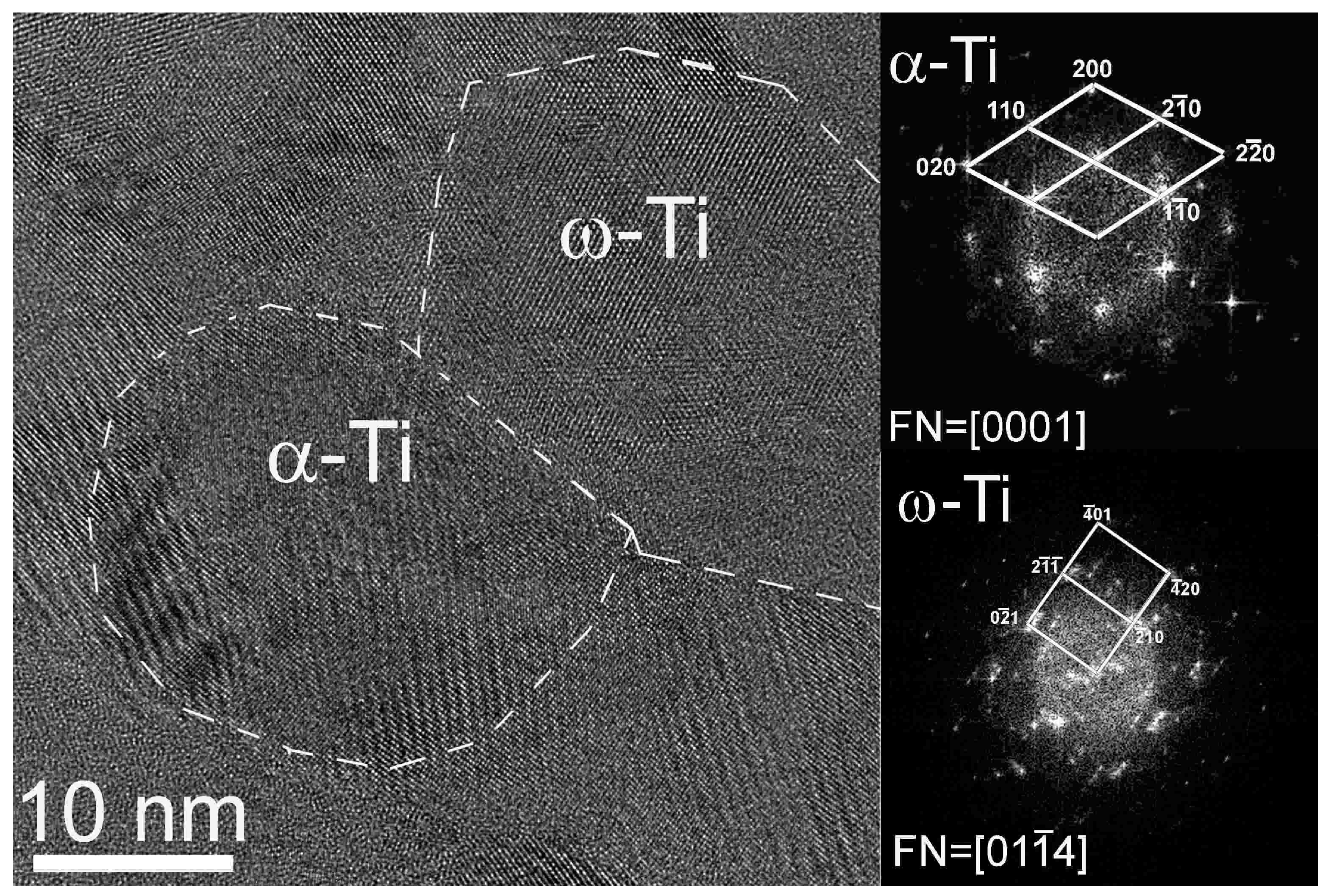
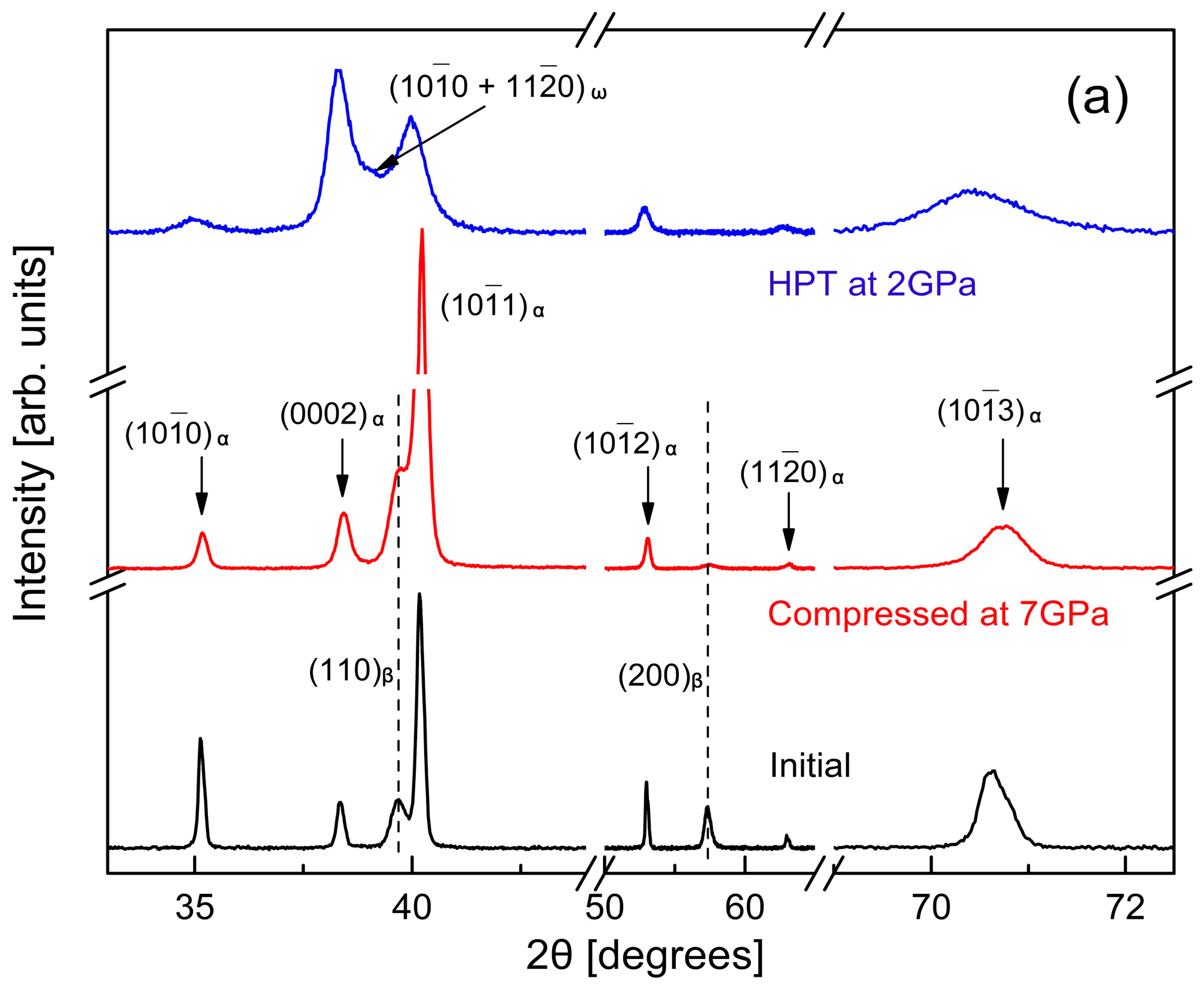
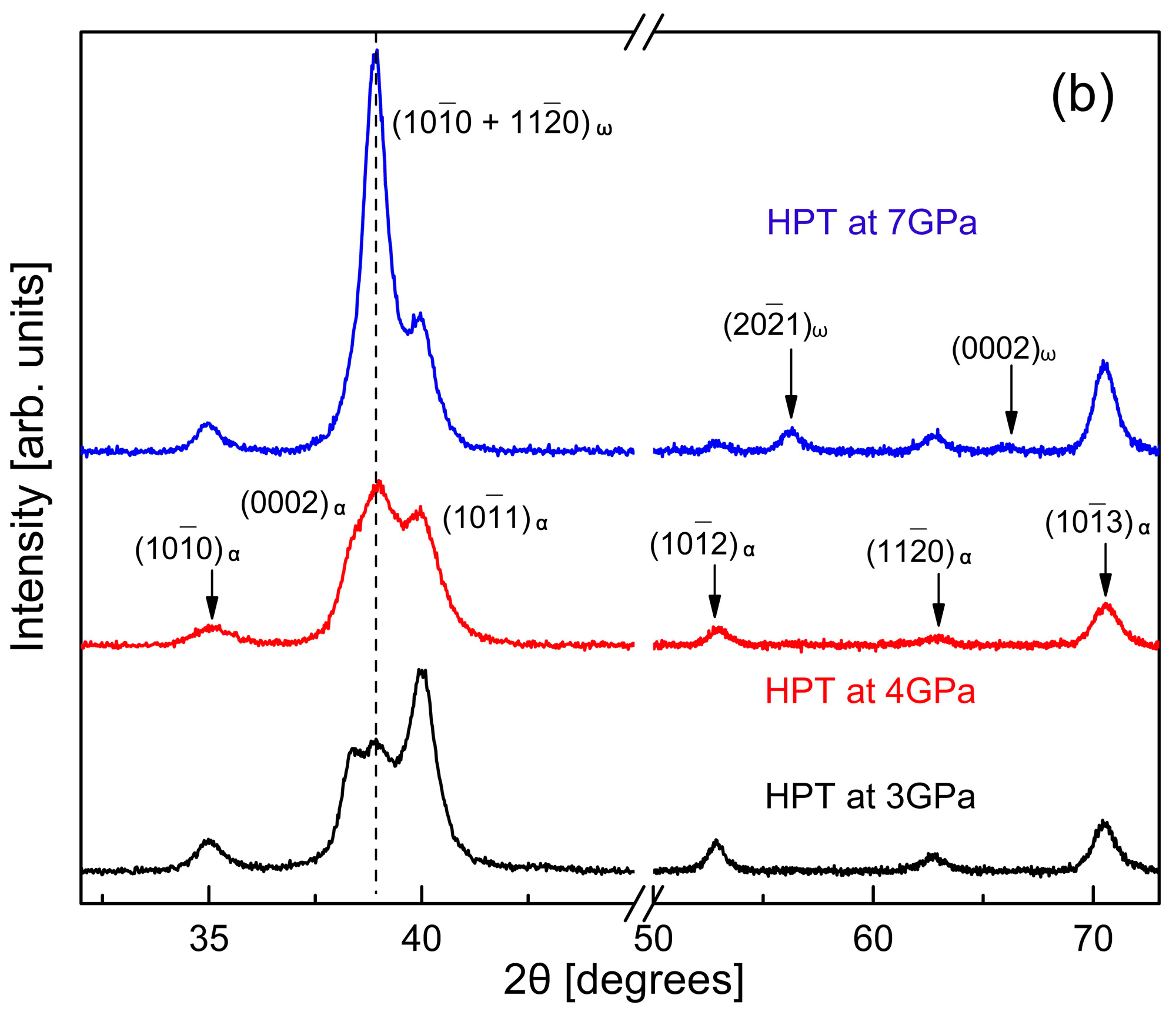
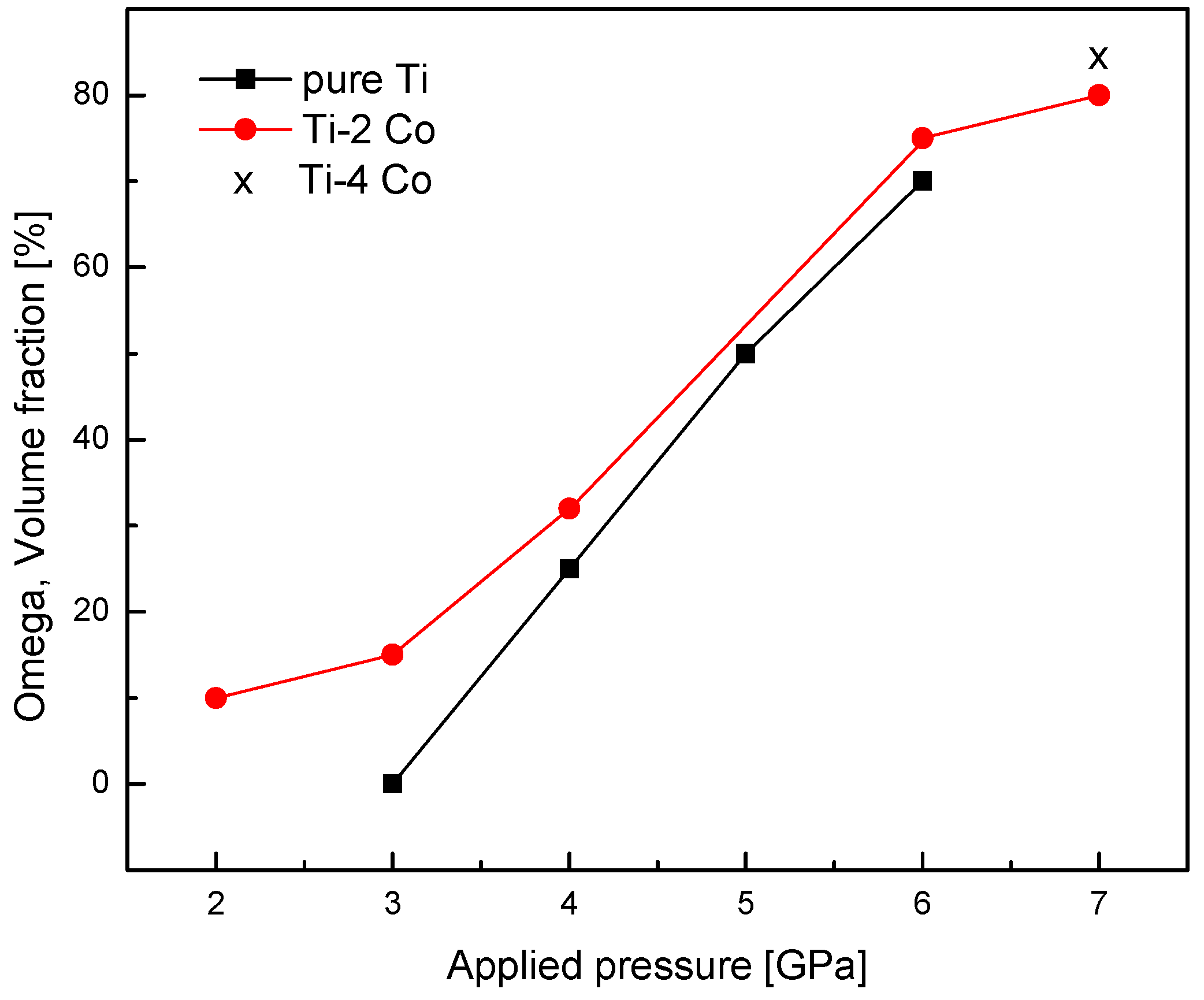
© 2017 by the authors. Licensee MDPI, Basel, Switzerland. This article is an open access article distributed under the terms and conditions of the Creative Commons Attribution (CC BY) license (http://creativecommons.org/licenses/by/4.0/).
Share and Cite
Kilmametov, A.R.; Ivanisenko, Y.; Straumal, B.B.; Gornakova, A.S.; Mazilkin, A.A.; Hahn, H. The α → ω Transformation in Titanium-Cobalt Alloys under High-Pressure Torsion. Metals 2018, 8, 1. https://doi.org/10.3390/met8010001
Kilmametov AR, Ivanisenko Y, Straumal BB, Gornakova AS, Mazilkin AA, Hahn H. The α → ω Transformation in Titanium-Cobalt Alloys under High-Pressure Torsion. Metals. 2018; 8(1):1. https://doi.org/10.3390/met8010001
Chicago/Turabian StyleKilmametov, Askar R., Yulia Ivanisenko, Boris B. Straumal, Alena S. Gornakova, Andrey A. Mazilkin, and Horst Hahn. 2018. "The α → ω Transformation in Titanium-Cobalt Alloys under High-Pressure Torsion" Metals 8, no. 1: 1. https://doi.org/10.3390/met8010001




